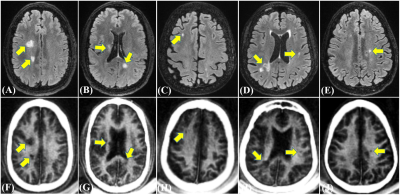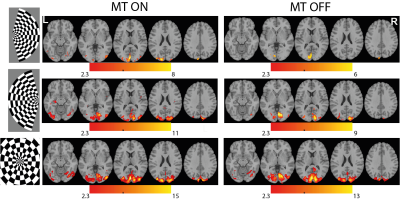Scientific Session
Novel Pulse Sequences and Reconstruction Techiques
Session Topic: Novel Pulse Sequences and Reconstruction Techiques
Session Sub-Topic: RF Pulses & Pulse Sequences
Oral
Acquisition, Reconstruction & Analysis
| Tuesday Parallel 4 Live Q&A | Tuesday, 11 August 2020, 14:30 - 15:15 UTC | Moderators: Emre Kopanoglu & Sydney Williams |
Session Number: O-62
 |
0604. |
Velocity encoded/compensated asymmetric multi-spoke RF pulses
Simon Schmidt1, Sebastian Flassbeck1, Mark E. Ladd1, and Sebastian Schmitter1,2
1Medical Physics in Radiology, German Cancer Research Center (DKFZ), Heidelberg, Germany, 2Physikalisch-Technische Bundesanstalt (PTB), Braunschweig and Berlin, Germany
In this work, we investigate the feasibility of velocity encoded/compensated asymmetric multi-spoke RF pulses. Bloch simulations, phantom studies, and in-vivo measurements are conducted to characterize the pulse performance. Compared to conventional multi-spoke RF pulses, the results indicate that asymmetric multi-spoke RF pulses are suitable for both 2D and 3D acquisitions and can significantly reduce the repetition time without compromising on velocity quantification. The hereby gained acceleration can be additionally combined with techniques such as GRAPPA or compressed-sensing to further decrease the total acquisition time.
|
0605. |
Multiband Adiabatic Inversion Using Multiphoton Excitation
Victor Han1 and Chunlei Liu1,2
1Electrical Engineering and Computer Sciences, University of California, Berkeley, Berkeley, CA, United States, 2Helen Wills Neuroscience Institute, University of California, Berkeley, Berkeley, CA, United States
We present a technique for power-efficient multiband adiabatic inversion using the concept of multiphoton excitation. In this case, multiphoton excitation occurs with one photon from our traditional RF source and one or more photons from oscillating gradients. By a proper choice of oscillating gradients, we can meet multiphoton resonance conditions at multiple spatial locations, and thus achieve multiband multiphoton adiabatic inversions. Only a slightly scaled standard adiabatic pulse is needed on the traditional RF side. We demonstrate the technique with simulations, phantom and in vivo experiments on a 3T scanner.
|
|
 |
0606. |
Robust Morphological Myelin Imaging Using a Short TR Adiabatic Inversion Recovery Prepared Ultrashort Echo Time (STAIR-UTE) Sequence
Yajun Ma1, Hyungseok Jang1, Zhao Wei1, Zhenyu Cai1, Yanping Xue1, Eric Y Chang2, Jody Corey-Bloom1, and Jiang Du1
1UC San Diego, San Diego, CA, United States, 2VA health system, San Diego, CA, United States
To image myelin in brain more robustly on clinical scanners, we propose a Short TR Adiabatic Inversion Recovery prepared UTE (STAIR-UTE) sequence for volumetric myelin imaging in vivo. With STAIR technique, long T2 tissues with a broad range of T1s can be sufficiently suppressed. High myelin contrast can be robustly obtained with a TR less than 250 ms. The resultant myelin imaging shows a clear loss of myelin signal in multiple sclerosis (MS) lesions.
|
 |
0607. |
Direct Saturation Control for Magnetization Transfer Imaging at 7T
David Leitão1, Raphael Tomi-Tricot2, Patrick Liebig3, Rene Gumbrecht3, Dieter Ritter3, Ana Baburamani4, Jan Sedlacik1,4, Joseph V. Hajnal1,4, and Shaihan J. Malik1,4
1Biomedical Engineering Department, School of Biomedical Engineering and Imaging Sciences, King's College London, London, United Kingdom, 2MR Research Collaborations, Siemens Healthcare Limited, Frimley, United Kingdom, 3Siemens Healthcare GmbH, Erlangen, Germany, 4Centre for the Developing Brain, School of Biomedical Engineering and Imaging Sciences, King's College London, London, United Kingdom
Systems with Magnetization Transfer (MT) are particularly sensitive to $$$B_1^+$$$ inhomogeneity, as the semisolid magnetization saturation is proportional to the square of $$$B_1^+$$$. This can be problematic at 7T imaging, where $$$B_1^+$$$ inhomogeneity is more severe, compromising the MT contrast obtained. This work proposes applying a composite MT prep-pulse with varying RF complex weights for each sub-pulse. These weights are optimized to deliver in the end a homogenous $$$\langle{}B_1^{+2}\rangle$$$, such that the MT contrast obtained is spatially uniform. Simulation and phantom results showed great improvement in the $$$\langle{}B_1^{+2}\rangle$$$ and MT ratio maps.
|
0608. |
Magnetization transfer enhanced functional contrast for short TE fMRI
Jenni Schulz1, Zahra Fazal1, Riccardo Metere1, José P Marques1, and David G Norris1,2
1Donders Institute for Brain, Cognition and Behaviour, Radboud University Nijmegen, Nijmegen, Netherlands, 2Erwin L. Hahn Institute for Magnetic Resonance Imaging, University Duisburg-Essen, Essen, Germany
Magnetization-transfer can be used to suppress tissue signal but not blood. This sensitises the signal to CBV variations. By minimising TE we can maximise the sensitivity to CBV variation while minimising BOLD contrast. We implemented a short TE (7.5 ms) GE-EPI protocol with MT preparation, and performed a brain activation study on three healthy volunteers using a visual stimulus paradigm. Tissue suppression factors of typically 53% were achieved with MT-on. Both MT-on and -off conditions gave significant activation owing to residual BOLD contrast in MT-off. However, the group level contrast MT-on > MT-off gave standard activation maps with significant activation.
|
|
0609. |
Time-optimized universal non-selective pulses for 7T MRI with parallel transmission
Léo Van Damme1,2, Frank Mauconduit2, Thomas Chambrion1,3, Nicolas Boulant2, and Vincent Gras2
1Institut Elie Cartan, Université de Lorraine, Vandoeuvre-lès-Nancy, France, 2Neurospin, CEA Saclay, Gif-sur-Yvette, France, 3INRIA Nancy Grand Est, Vandœuvre, France
Parallel transmission is a promising technology in high field MRI to mitigate the RF field inhomogeneity problem. In that context, the so-called Universal kT-point technique proves useful to achieve uniform spin excitation at no cost in terms of radio-frequency field calibration, although localized artefacts can occasionally appear due to the presence of very large resonance frequency offsets. By exploring more general RF pulse and magnetic field gradient waveforms than kT-points, this work introduces time-minimized universal pulses presenting better broadband behavior. In-vivo acquisitions on 5 volunteers at 7T have been performed to demonstrate the improvements.
|
|
0610. |
In-plane simultaneous multi-segment imaging: example employing diffusion-weighted imaging using a 2D RF pulse
Kaibao Sun1, Zheng Zhong1,2, Zhongbiao Xu3, Guangyu Dan1,2, M. Muge Karaman1,2, and Xiaohong Joe Zhou1,2,4
1Center for MR Research,University of Illinois at Chicago, Chicago, IL, United States, 2Department of Bioengineering, University of Illinois at Chicago, Chicago, IL, United States, 3Department of Radiotherapy,Cancer Center,Guangdong Provincial People's Hospital & Guangdong Academy of Medical Science, Guangzhou, China, 4Departments of Radiology and Neurosurgery, University of Illinois at Chicago, Chicago, IL, United States
Reduced field of view (rFOV) imaging offers several advantages, including high spatial resolution and reduced image distortion. We propose an in-plane simultaneous multi-segment (IP-SMS) imaging method to extend the benefits of rFOV to full FOV imaging. Unlike the conventional simultaneous multi-slice imaging, IP-SMS performs in-plane simultaneous multi-segment excitation by utilizing the periodic replicas of excitation profile of a 2D RF pulse, followed by parallel segment reconstruction using a set of “virtual” coil sensitivity profiles. We have demonstrated the IP-SMS imaging technique on phantoms and human brains where high-resolution diffusion images were obtained with minimal distortion.
|
|
0611. |
DeepRF: Designing an RF pulse using a self-learning machine
Dongmyung Shin1 and Jongho Lee1
1Department of Electrical and Computer Engineering, Seoul National University, Seoul, Korea, Republic of
Designing an RF pulse or developing a design rule requires a deep understanding of MR physics, and, therefore, is not easy. In this work, we demonstrate that an AI agent can self-learn the design strategy of an RF pulse and successfully generate a complex RF pulse (adiabatic RF) that satisfies given design criteria. The machine-designed pulse has a substantially different shape but shows performance comparable to the conventional adiabatic pulse.
|
|
0612. |
INSTANT (INtegrated Shimming and Tip-Angle NormalizaTion): 3D flip-angle mitigation using joint optimization of RF and shim array currents
Mads Sloth Vinding1,2, Torben Ellegaard Lund1,2, Jason P Stockmann3,4, and Bastien Guérin3,4
Video Permission Withheld
1Department of Clinical Medicine, Aarhus University, Aarhus, Denmark, 2Center of Functionally Integrative Neuroscience, Aarhus University Hospital, Aarhus, Denmark, 3A. A. Martinos Center for Biomedical Imaging, Massachusetts General Hospital, Charlestown, MA, United States, 4Harvard Medical School, Boston, MA, United States
We generalize a composite pulse approach used with an RF/multi-coil shim array, whereby we optimize the RF and shim array waveforms played simultaneously for 3D flip-angle homogenization at 7 Tesla in the human head. We show that this approach yields shorter pulses at a given excitation error than when optimizing the RF alone. In other words, the original intuition of the composite pulse approach of RF pulses surrounding DC shim current blips is extended to concurrent RF and shim current and the additional degrees-of-freedom played as continuous shim waveforms significantly improves the excitation quality (uniform 90º excitation).
|
|
0613. |
Improvements in flip-angle uniformization at 7 Tesla using an integrated RF/B0 shim array coil and composite pulses
Bastien Guerin1,2, Eugene Milshteyn1,2, Lawrence L Wald1,2, and Jason Stockmann1,2
1Martinos Center for Biomedical Imaging, Massachusetts General Hospital, Charlestown, MA, United States, 2Harvard Medical School, Boston, MA, United States
We compare the RF/B0 shim array composite pulses of Rudrapatna [1] to kT-point and spoke pulses for flip-angle (FA) uniformization using a birdcage coil at 7T. Using 3 kT-points, it is possible to obtained highly uniform flip-angle distributions in the brain within 3ms, as long as the kT-points locations are optimized. The RF/B0 shim array pulses perform less well than this optimized 3-kT-points strategy for non-selective flip-angle mitigation, but better than optimized 3-spoke pulses for flip-angle mitigation in a slice. The DOFs provided by shim array coils could prove invaluable for integrated B0 shimming and flip-angle uniformization at 7T.
|

 Back to Program-at-a-Glance
Back to Program-at-a-Glance Watch the Video
Watch the Video Back to Top
Back to Top